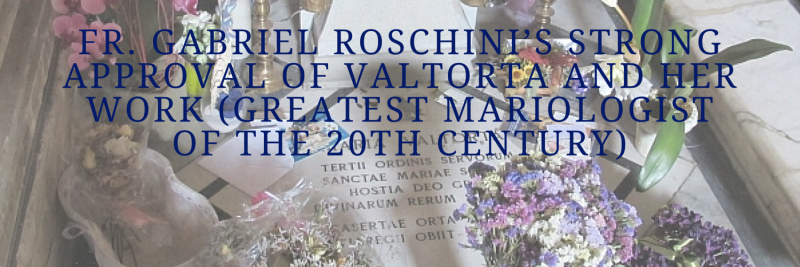

Consultant to the Holy Office, Professor at the Marianum Pontifical
Faculty of Theology in Rome and at the Lateran Pontifical University
Fr. Gabriel Roschini, O.S.M. (1900-1977), was a world-renowned Mariologist, decorated professor and founder of the Marianum Pontifical Faculty of Theology in Rome in 1950 under Pope Pius XII, professor at the Lateran Pontifical University, and a Consultant to the Holy Office and the Sacred Congregation for the Causes of Saints. During the pontificate of Pope Pius XII, he worked closely with the Vatican on Marian publications. He is considered by many to be the greatest Mariologist of the 20th century, was highly esteemed by all the Popes during his priestly life (especially Pope Pius XII), and was often referred to by Pope John Paul II as one of the greatest Mariologists who ever lived. Fr. Roschini has written over 790 articles and miscellaneous writings, and 130 books, 66 of which were over 200 pages long. Most of his writings were devoted to Mariology. He was also at some time Prior General of the Order of the Servants of Mary, Vicar General, and General Director of its studies. He was also a member of several scholarly academies, and vice-president of the Pontifical Academy of Our Lady Immaculate (founded in 1847).1
An article on Gabriel Roschini relates:2
During the pontificate of Pope Pius XII, he worked closely with the Vatican on Marian publications. In light of the encyclopedic accuracy of his work, Roschini is considered as one of the top two Mariologists in the 20th century. His first major work, a four volume Mariology, Il Capolavoro di Dio, is judged to be the most comprehensive Mariological presentation in the 20th century. Several theologians called him "one of the most profound Mariologists" and "irreplaceable".
Fr. Roschini had personally met Maria Valtorta, but admitted that, like many others, he was a respectful and condescending skeptic. But after carefully studying her writings for himself, he underwent a radical and enthusiastic change of heart, later declaring Valtorta to be “one of the eighteen greatest mystics of all time.”3 In his last book of 395 pages, which he said was his most important book, The Virgin Mary in the Writings of Maria Valtorta, he declared that the Mariology found in Maria Valtorta’s writings exceeds the sum total of everything he has read, studied, and published himself (and he has published over 790 articles and miscellaneous writings, and 130 books, 66 of which were over 200 pages long – almost all of which are on Mariology). His book, The Virgin Mary in the Writings of Maria Valtorta, received a letter of acknowledgement of receipt and praise from the Sovereign Pontiff at the time of publication, and this letter (with Vatican insignia) is copied and viewable in the appendix of his book and is also copied further below in this present article.4 As material for a course which he taught at the Marianum Pontifical Theological Faculty in Rome on the Marian intuitions of the great mystics, Fr. Gabriel Roschini used both Maria Valtorta’s The Poem of the Man-God as well as her other mystical writings as a basis for his course.5 Fr. Roschini is also one of the authorities whose favorable certifications about Maria Valtorta was given to the Holy Office in 1961 by Fr. Corrado Berti, which led the Holy Office to grant their approval of the publication of the second edition of her work.6Fr. Gabriel Roschini, O.S.M., in his last book of 395 pages, The Virgin Mary in the Writings of Maria Valtorta, outlines the greatest female Marian mystics of all time:7
III. THE GREATEST FEMALE MARIAN MYSTICS
The greatest female Marian mystics in ancient and modern times are:
- St. Hildegarde of Bingen, Benedictine (1098-1179), known as “the Sibyl of the Rhine”;
- St. Mechtildis of Helfta (St. Matilda), Cistercian (1241-1299);
- St. Gertrude the Great, Cistercian (1256-1302 or 1309), the greatest mystic of the 13th century;
- Blessed Angela of Foligno, secular Franciscan (1246-1309);
- St. Bridgèt of Sweden (Birgitta) (1309-1373), “the Northern Mystic”;
- St. Catherine of Siena, tertiary Dominican (1347-1380), Doctor of the Church;
- St. Mary Magdalen of Pazzi, Carmelite (1566-1607);
- Venerable Maria de Agreda, Franciscan (1602-1665);
- St. Veronica Giuliani, Capuchin (1660-1727);
- Blessed Mary-Magdalen Martinengo, Capuchin (1687-1737);
- Servant of God Mary of St. Theresa Petit, Third Order Carmelite (1623-1677);
- Venerable Mary-Archangel Biondini, of the Handmaids of Mary (1641-1712);
- Servant of God Cecil Bay, Benedictine (1694-1766);
- Venerable Anne Catherine Emmerich, Augustinian (1774-1824);
- Servant of God Marie Véronique of the Heart of Jesus, founder of the Institute of the Victims of the Sacred Heart of Jesus (1825-1883);
- Guglielmina Ronconi (1864-1936);
- Servant of God Lucia Mángano, Ursuline (1896-1946);
- Maria Valtorta, tertiary of the Order of Servants of Mary (1897-1961).
I have been studying, teaching, preaching, and writing Mariology for half a century already. To do this, I had to read innumerable works and articles of all kinds on Mary: a real Marian library.
However, I must candidly admit that the Mariology found in all of Maria Valtorta's writings – both published or unpublished – has been for me a real discovery. No other Marian writings, not even the sum total of everything I have read and studied, were able to give me as clear, as lively, as complete, as luminous, or as fascinating an image, both simple and sublime, of Mary, God's Masterpiece.
It seems to me that the conventional image of the Blessed Virgin, portrayed by myself and my fellow Mariologists, is merely a paper mache Madonna compared to the living and vibrant Virgin Mary envisioned by Maria Valtorta, a Virgin Mary perfect in every way.
...whoever wants to know the Blessed Virgin (a Virgin in perfect harmony with the Holy Scriptures, the Tradition of the Church, and the Church Magisterium) should draw from Valtorta's Mariology.
If anyone believes my declaration is only one of those ordinary hyperbolic slogans abused by publicity, I will say this only: let them read before they judge!
Fr. Gabriel Roschini’s book is available for purchase online.
Maria Valtorta died on October 12, 1961. An article relates: “The rector of the Third Order of the Servants of Mary, Fr. Innocenzo M. Rovetti, assisted her at her deathbed. At the very moment the priest recited the words: Proficiscere, anima Christiana, de hoc mundo (“Depart, o Christian soul, from this world”), Maria breathed her last. Ten years after Maria Valtorta’s death, on October 12, 1971, her mortal remains were exhumed from the earth and placed in the family niche. On the 2nd of July 1973, however, with civil and ecclesiastic permissions, they were transferred from Viareggio to Florence to be entombed in the Capitular Chapel in the Grand Cloister of the Basilica of the Most Holy Annunciation [the mother church of the Servite Order], where the tomb of Maria Valtorta is still venerated.”9 Fr. Gabriel Roschini, O.S.M., world-renowned Mariologist, wrote that after her death, “People noticed that her right hand – with which she had written so many sublime texts – contrarily to her left hand, retained the color, suppleness, and beauty of someone alive rather than dead.”10 Fr. Roschini presided over the relocation of the remains of Maria Valtorta from Viareggio to the Grand Cloister of the Basilica of the Most Holy Annunciation, including presiding over the Mass, giving the appropriate discourse for this occasion, and giving the blessing for her burial.11 The inscription on her tomb reads: “Divinarum Rerum Scriptrix” (Writer of Divine Things).
Here is a photocopy of the signed letter dated January 17, 1974, that the Vatican Secretary of State wrote to Fr. Gabriel Roschini, O.S.M., and which was published in Fr. Roschini’s book, The Virgin Mary in the Writings of Maria Valtorta (the English translation will follow afterwards):
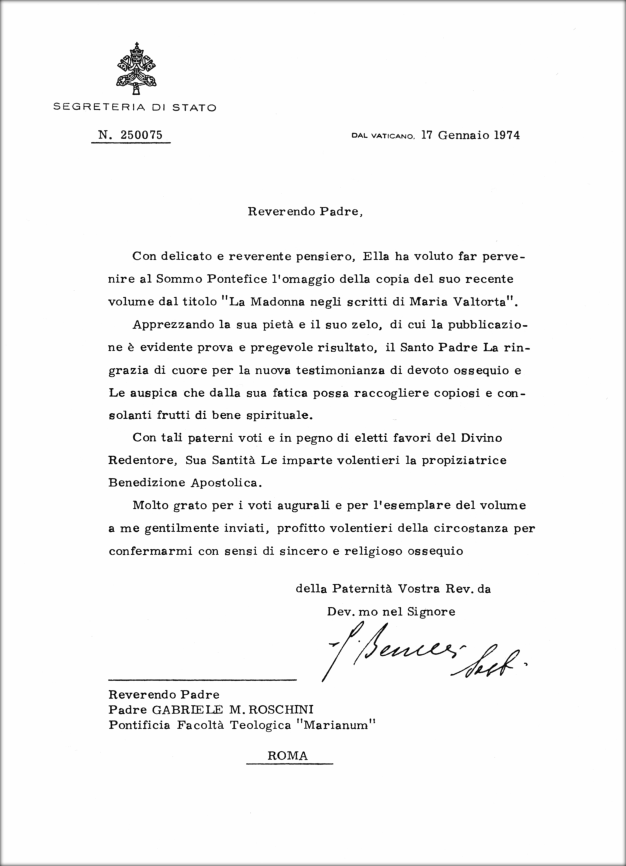
English translation of the letter of Pope Paul VI’s Secretary of State:
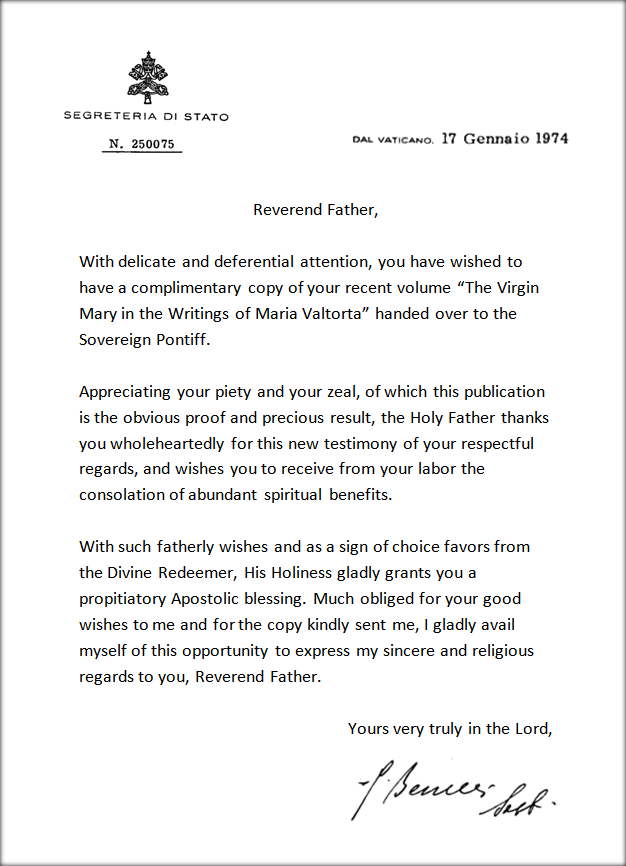
This letter, penned by the Secretariat of State and authorized by the Pope, undoubtedly conveys a positive tone, praising the author for his "piety and his zeal, for which this publication is the obvious result". It is illogical to conclude that the Pope would authorize such a letter, if he thought the writings were condemned or contained error. The Secretariat of State is highest ranked curial official next to the Pope, and is considered the Popes’ "right arm". Those who question whether the letter was written with the Pope’s authorization are advised to look up the job description for the Secretariat of State, for this is what he does. Even though the Pope may not have put the pen to the paper, the implication is the same. This event falls naturally in line with the Holy Father’s action decades earlier of sending the complete writings [of Maria Valtorta] to the Milan seminary library.
Dr. Mark Miravalle, S.T.D. (Doctor of Sacred Theology), wrote:13The extensive Mariology contained in The Poem was also the subject of a 400-page study written by arguably the greatest Italian mariologist of the twentieth century and Consultor of the Holy Office, Rev. Gabriel Roschini, O.S.M. In a letter of January 17, 1974, Father Roschini received the congratulations of Pope Paul VI for his work entitled, The Virgin Mary in the Writings of Maria Valtorta. The letter from the Secretary of State notes, "The Holy Father thanks you wholeheartedly for this new testimony of your respectful regards and wishes you to receive from your labor the consolation of abundant spiritual benefits." Neither the papal benediction granted by Pope Paul VI nor the papal congratulations issued through the Secretary of State would have been granted to a text based on a series of private revelations which were "forbidden" or declared "doctrinally erroneous" by the Congregation for the Doctrine of the Faith.
This article has demonstrated the significant admiration, approval, and dedication that Fr. Roschini had of Maria Valtorta and her writings. However, Fr. Roschini is not the only renowned theologian and Consultant of the Holy Office and the Congregation for the Causes of Saints who has approved, endorsed, or praised Maria Valtorta's work.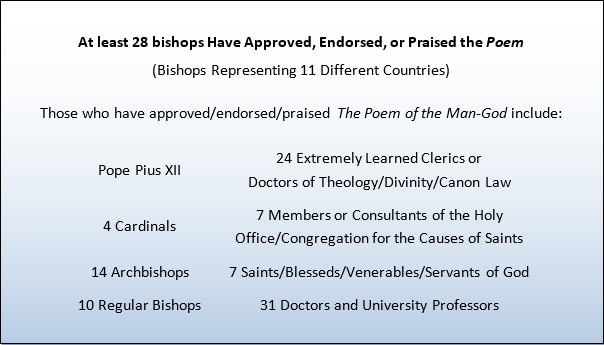
Testimonies, statements, and documentation for every one of the above listed clerics and lay faithful are provided in A Summa and Encyclopedia to Maria Valtorta’s Extraordinary Work in the subchapter of the e-book entitled “Proof by the Testimony of Countless Trustworthy Clerics, Authorities, Experts, Scientists, and Pious Lay Faithful and the Tremendously Good Fruits Produced in Individuals and in the Church as a Whole”.
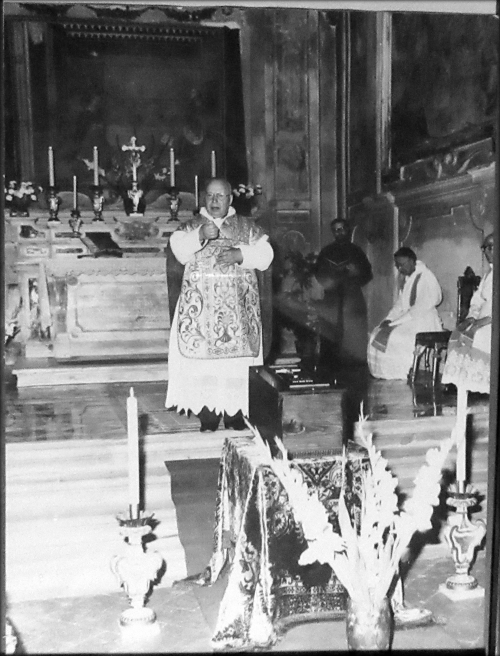
Giving a Homily During the Burial Mass of Maria Valtorta in the Grand Cloister of the Basilica of the Most Holy Annunciation
1. The Virgin Mary in the Writings of Maria Valtorta. By Fr. Gabriel M. Roschini, O.S.M. Kolbe's Publications Inc. 1989. Page XIV in the Foreword. ISBN-13: 9788879870863.
2. Gabriel Roschini. Wikipedia. Accessed online May 2016.
https://en.wikipedia.org/wiki/Gabriel_Roschini
3. An Introduction to Maria Valtorta and Her Epic Narrative The Poem of the Man-God. Accessed online May 2016.
http://www.bardstown.com/~brchrys/Valepic.html
4. The Virgin Mary in the Writings of Maria Valtorta. Appreciation by Pope Paul VI and Translation. Op. cit.
5. The Virgin Mary in the Writings of Maria Valtorta. Page XIII in the Publisher’s Notice. Op. cit.
6. An Introduction to Maria Valtorta and Her Epic Narrative The Poem of the Man-God. Op cit.
7. The Virgin Mary in the Writings of Maria Valtorta. pp. 8-9. Op. cit.
8. The Virgin Mary in the Writings of Maria Valtorta. Foreword. Op. cit.
9. Preface to the Poem of the Man-God. Maria-Valtorta.net. Accessed online May 2016.
http://maria-valtorta.net/poem_man_god_preface.html
10. The Virgin Mary in the Writings of Maria Valtorta. p. 6. Op. cit.
11. The Virgin Mary in the Writings of Maria Valtorta. Page XIII in the Publisher’s Notice. Op. cit.
12. A Brief History of Events. Maria-Valtorta.net.
http://www.maria-valtorta.net/index.html
13. In Response to Various Questions Regarding "The Poem of the Man-God”. By Dr. Mark Miravalle, S.T.D. April 15, 2006.
http://www.motherofallpeoples.com/2006/04/in-response-to-various-questions-regarding-qthe-poem-of-the-man-godq/




